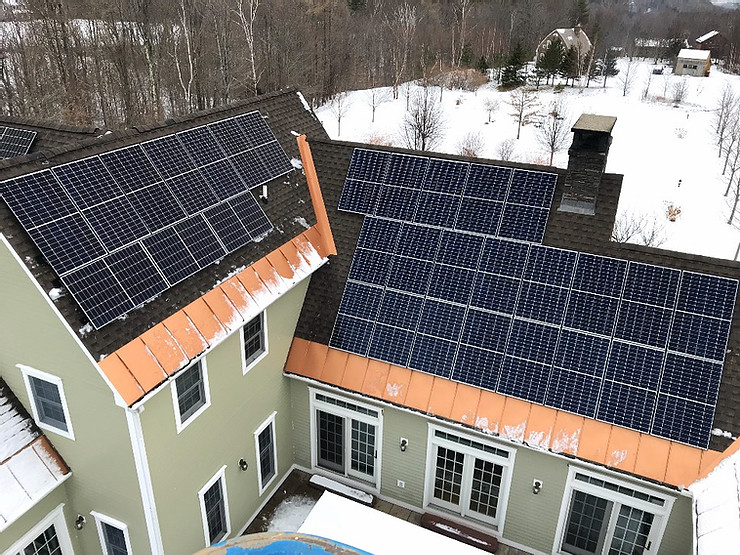You know what powder days look like on the slopes, but what does it mean for your solar panels? The good news: You don’t need to get cold feet for solar because of the snow.

Burlington, Vermont gets an average of 73 inches of snow a year (and that’s not even the snowiest part of the state!). Solar owners might look at the beautiful blanket of snow and wonder—How much does snow hurt my solar production?
Surprisingly, you don’t have to add shoveling off your roof to your winter chores. For starters, your solar panels can still produce power under two or three inches of snow. It’s reduced, but you don’t go down to zero until you get upwards of four inches.
“Snow hurts production at that time,” explains Ben McFeeters lead solar and battery technician at Green Mountain Solar. But that’s far from the whole story. “We size our systems to account for a certain number of snow days a year,” he continues. “So, while, yes, you might lose some production that day or that week, you’re not losing a ton of production for the year because you typically don’t make that much production in the winter anyway. In the summer at my house, I’ll make 70kwh. On a sunny winter day, I’ll make 10-20kwh. It’s drastically reduced based on the sun angle and the length of the day.”
“One thing I tell people is, it’s not worth climbing up a ladder, using a roof rake, putting yourself in danger to make those extra couple dollars of solar production,” says Ben. “It’s just not worth it.”
The other important factor to consider is the type of inverter your installer uses. The inverter is the equipment behind the solar panel that converts the solar power into a form your house can use. Inverters can generally be divided into two categories: string inverters and microinverters. With string inverters, if one panel is covered in snow, the entire array will underperform to the level of that one panel. (Sort of like with Christmas lights: If one goes out, the entire string goes dark.) But microinverters are installed one per panel so snow on one part of your array won’t impact performance on a different area. Green Mountain Solar predominantly uses the Enphase microinverters so that snow will have a lower impact on your system’s performance overall.
How Solar Panels Shed Snow
Another thing to consider: Solar panels themselves are pretty good at doing the snow removal for you. (Now if only my driveway could do the same thing…)
“Solar panels are definitely good at shedding snow on their own,” says Ben. “Especially with roof-mounted systems, you will get some heat loss through the attic, and that will warm up the panels even before the suns out. And once you get a little bit of the panel clear, they really start warming up. They will start warming up and shedding snow fairly quickly in most conditions, even on a 25-degree pitch roof it will come off.”
How Do I Get Snow Off My Solar Panels?
“While we don’t recommend it, we understand that people see snow on their panels and see money going out the window, so I can’t fault anyone for trying,” says Ben. So if you’re really determined to keep your panels clear, here are a few things to keep in mind.
“Anything that can scratch or shatter your panels is obviously a no-no,” he says. The best tool is a roof rake with a piece of foam or sponge on the edge. “It can get some of the big fluffy stuff off. As long as you’re gentle with them! You don’t want to scratch them. You don’t want to hit them real hard when they’re cold—they are glass and they will break.”
This is a key point for Ben: He has seen people shatter parts of their array trying to keep it clear of snow. Ultimately, the potential cost of replacing a damaged panel far outweighs the small savings you get by preserving the winter production.
Have more questions on solar in Vermont? Our team of local experts are here to answer all of them! Click here to get started.
By Julia Westbrook

Leave a Comment